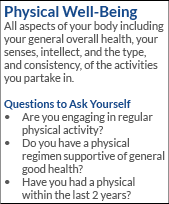 The VITAL WorkLife Wheel of Well-Being is a tool used to evaluate distinct areas of life and build overall well-being through improving each dimension of well-being. Your overall well-being is made of multiple dimensions. Physical Well-Being is one dimension contributing to your holistic health; you cannot achieve overall well-being without having balance in each of the dimensions.
The VITAL WorkLife Wheel of Well-Being is a tool used to evaluate distinct areas of life and build overall well-being through improving each dimension of well-being. Your overall well-being is made of multiple dimensions. Physical Well-Being is one dimension contributing to your holistic health; you cannot achieve overall well-being without having balance in each of the dimensions.
Physical Well-Being
At VITAL WorkLife, we define Physical Well-Being as:
"Understanding the roles sleep, nutrition, exercise, movement, preventative care and positive behaviors play in promoting well-being"
What Contributes to Physical Well-Being?
Poor lifestyle choices can lead to the development of chronic disease, defined as an “incurable illness or health condition persisting for a year or more, resulting in functional limitations and the need for ongoing medical care.” Examples are obesity, cardiovascular disease, cancer and diabetes. Despite knowledge of preventability and manageability through early detection, treatment and healthy living, chronic disease typically leads to some degree of physical or mental impairment in at least 25% of those diagnosed with a condition.² Of the leading causes of death in the US, 57% were caused by cardiovascular disease or cancer, and nearly 80% of these deaths could have been prevented by following a healthy lifestyle.³
Failing to maintain your physical well-being can result in a rapid decline in health status. Physical activity alone has been proven to reduce the risk of high cholesterol levels, obesity, high blood pressure, heart disease, as well as prevent muscular degeneration. Activity loss can eventually lead to muscular dysfunction, increasing the risk of injury and falls, and also significantly limit daily living activities (ADL’s), the basic, day-to-day self-care tasks such as bathing, eating, dressing and even mobility.³ For many, losing the ability to partake in ADLs can mean a loss of independence, leading to depression, decreased social functioning, shortened life expectancy and decreased quality of life. All of these factors can have a negative effect on other dimensions, especially Emotional and Relational.
Case Study
Andrew had always been highly physically active. He was an athlete in college, working out every day and eating a strict diet. But lately the pressures of medical school, his new marriage and now a new job living away from family and friends was taking a toll. He barely had time to fit in any physical activity and his marriage was strained due to the demands of his job. Andrew was feeling a lack of confidence not only due to excessive weight gain, but also being new in his role and feeling unfulfilled professionally. His lack of work/life balance didn’t seem to leave time for much of anything.
Andrew decided to take a good look at his life.
By talking to a new peer coach, someone who understood his unique challenges, Andrew learned by improving his Physical Well-Being he could also improve a number of the other dimensions of his life. He realized there were quite a few small changes he could make in his life to also improve his professional, emotional and relational dimensions.
His wife really liked to cook, so Andrew suggested they spend time together planning/shopping/preparing healthy meals for the week. He also asked a couple of colleagues to work out once a week and started playing a weekly game of basketball at the rec center; two reasons to schedule much-needed activity. His new peer coach also offered suggestions for how to get more connected at work to grow professionally in his new role. By focusing on his physical well-being, Andrew was able to get the balance he needed in his job and personal life. He is spending more time with his wife and his is back to healthy exercise and diet. He and his wife have even signed up to run in a few upcoming 5K races together. Andrew is happier, healthier and more productive at work because he focused on improving his physical well-being!
How to Achieve and Maintain Physical Well -Being?
Physical Well-Being involves creating a plan to ensure you are getting regular physical activity, eating healthy and getting enough sleep to balance all dimensions of your well-being. There are plenty of resources available to you to improve your health and be on your way to a long, fulfilling life!
To learn more about your Physical Well-Being dimension, you can read from our recommended reading list.
- "Physical Well-Being." American Association of Nurse Anesthetists, 2016. Web. 29 Mar. 2016. http://www.aana.com/resources2/health-wellness/Pages/Physical-Well-Being.aspx
- Clark, Micheal, Brian G. Sutton, and Scott Lucett. "Fundamental of Human Movement Science." NASM Essentials of Personal Fitness Training. Burlington: Jones & Bartlett Learning, 2014. N. pag. Print.
- Kernisan, Leslie, and Paula Scott. "Activities of Daily Living: What Are ADLs and IADLs?" Caring.com. N.p., n.d. Web. 29 Mar. 2016. https://www.caring.com/articles/activities-of-daily-living-what-are-adls-and-iadls
We Can Help
VITAL WorkLife supports all dimensions of your Wheel of Well-Being. Call us anytime, day or night, for support of your Physical Well-Being.
- EAP members call 800.383.1908 or access resources through your VITAL WorkLife App
- Physician Well-Being Resources members call 877.731.3949 or access resources through your VITAL WorkLife App
Check out our video below to learn more about the Wheel of Well-Being:


